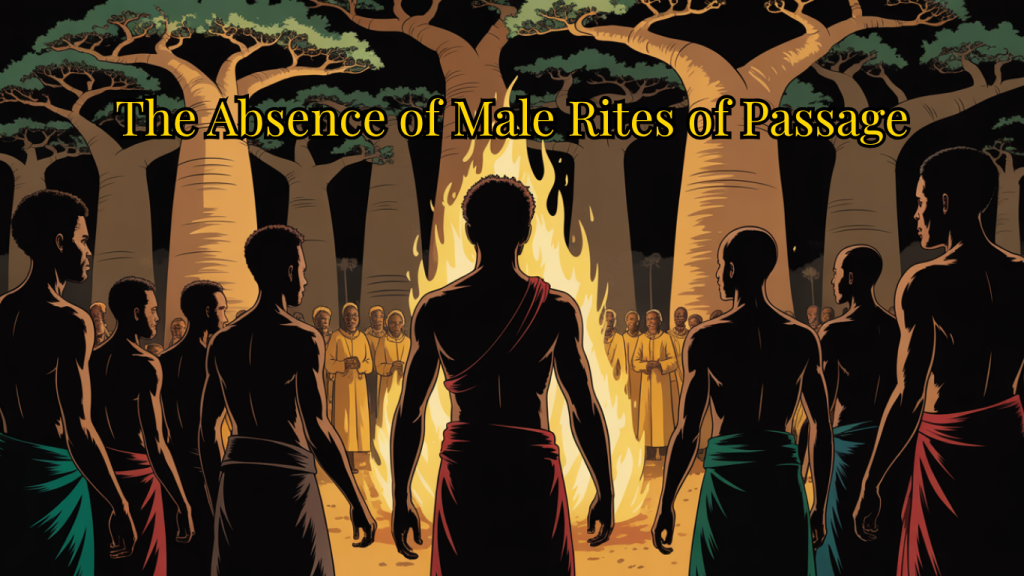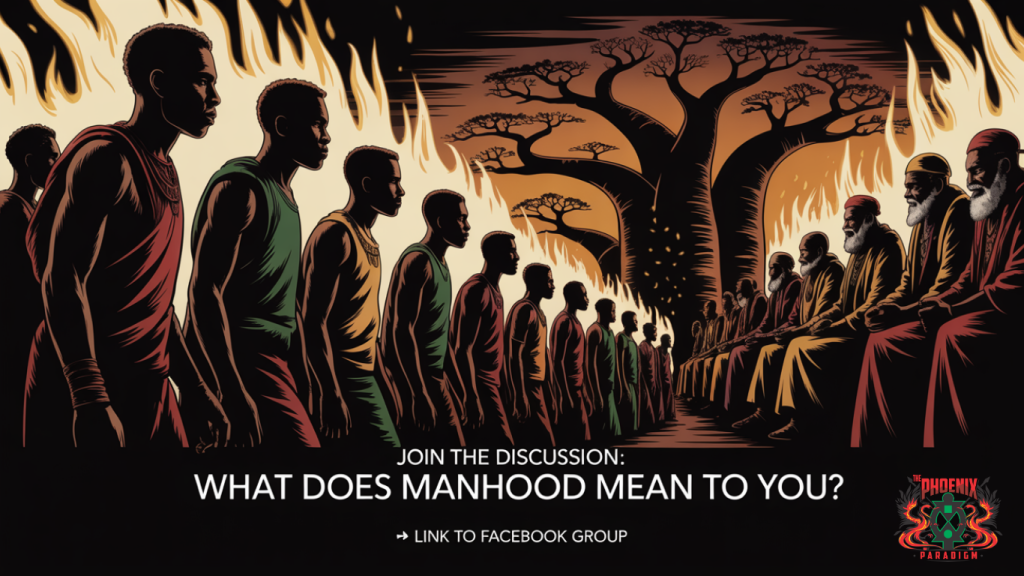The Absence of Male Rites of Passage in the Black Community: A Crisis of Identity and Continuity

By The Phoenix Paradigm | Special Report
I. Introduction: A Generation Uninitiated
Across the African Diaspora, rites of passage once marked the transition from boyhood to manhood—rituals of courage, community, and consciousness. These rites affirmed belonging, responsibility, and purpose. Today, however, much of the Black community in America faces a silent void where these communal pathways once stood. The erosion of structured initiation has created an existential gap, leaving too many young men to seek belonging through violence, technology, or self-destructive patterns that mimic but never replace true initiation.
Recent research in psychology and sociology underscores that the absence of rites of passage is not merely cultural—it is psychological, developmental, and spiritual. Stephen Granach’s seminal thesis, Ceremonial Rites of Passage for Adolescent Boys (2001), found that youth “require ritual transformation to cross the boundary from childhood to manhood” and that
“Without elders, community, and symbolic death, society loses its means to transmit values” — Stephen Granach 2001
In the African American context, this absence is layered atop centuries of cultural disruption. From the forced separations of slavery to the fragmented communities of postindustrial urban life, the threads of initiation have been frayed. Yet, reintroducing these traditions may hold the key to restoring identity, resilience, and communal integrity.
II. The Cultural and Psychological Vacuum
According to José Causadias et al. (2022) in Future Directions on BIPOC Youth Mental Health, cultural rituals serve as both sociological glue and psychological anchor—providing a sense of belonging, identity, and moral orientation. Their absence among Black youth, especially in times of social isolation and racial stress, correlates with heightened anxiety, alienation, and loss of purpose.
Rites of passage—rooted in African cosmology—were not just ceremonies but educational systems of character formation. As Granach’s study shows, effective initiations involve:
- Preparation (learning values and discipline),
- Separation (detachment from childhood identity),
- Trials and Hardship (developing courage and endurance),
- Symbolic Death and Rebirth, and
- Reintroduction and Service to the Community.
Without these, modern youth face what psychologist Erik Erikson described as role confusion. Communities lose coherence, and young men substitute ritual for rebellion—gang initiation, drug experimentation, hypersexuality, or digital escapism.
The Sociological Impact of Lost Rites of Passage
| **Dimension** | **Traditional Function (Pre-Colonial & Early Diaspora)** | **Modern Absence Effect (Post-1970s)** | **Interpretive Framework** | |
|---|---|---|---|---|
| **Identity Formation** | Initiated boys received a new name and adult social role. | Role confusion, performative masculinity, identity crises. | *Symbolic Interactionism* | |
| **Community Cohesion** | Intergenerational mentorship; elders affirmed belonging. | Isolation, distrust, absence of moral anchors. | *Functionalism* | |
| **Moral Development** | Tests of endurance and service instilled discipline. | Moral relativism, impulse-driven behavior, anti-authority. | *Conflict Theory* | |
| **Cultural Transmission** | Oral history, mythology, and lineage reaffirmed values. | Cultural amnesia, loss of ancestral consciousness. | *Pan-Africanism* | |
| **Psychological Resilience** | Ritualized hardship built coping mechanisms. | Depression, anxiety, attraction to violent subcultures. | *Developmental Psychology* | |
| **Technology Substitution** | None — human mentorship central. | AI companions mimic empathy, deepen detachment. | *Postmodern Critique* |
III. The Digital Displacement of Human Guidance
Senator Mark Warner’s GUARD Act (2025) highlights a chilling modern phenomenon: children turning to AI chatbots for companionship and emotional validation. Warner warns that “nearly 70% of teenagers are turning to chatbots as a substitute for friendship, making them more isolated and disconnected”.
This reliance on artificial empathy exposes a moral and cultural deficit—one that could be mitigated by authentic community mentorship and rites of passage. The same human guidance once offered by village elders or community fathers is now outsourced to machines, deepening detachment from genuine human and cultural lineage.
“Technology connects us faster than ever, but without wisdom it only multiplies our loneliness.” — Cornel West
The absence of elder-led initiation leaves a vacuum that predatory technologies readily fill. As AI-generated pseudo-friendships grow, the lack of grounded, real-world guidance becomes a matter of survival—particularly for Black youth whose sense of identity has already been eroded by systemic inequities.
IV. Sociological Framework: Functionality, Conflict, and Symbolism
Functionalism views rituals as stabilizers of society—creating cohesion and moral continuity. Their absence results in anomie, or moral disorientation. In the Black community, this manifests as a loss of intergenerational structure, weakened family systems, and a fractured sense of collective identity.
Conflict theory exposes how systemic forces—racism, incarceration, poverty—undermine self-determination. The erosion of rites of passage is not accidental; it mirrors institutional neglect that profits from chaos and disunity. As schools and prisons replace elders and initiators, young men’s natural rites become criminalized.
Policy & Prevention Infographic (GUARD Act Connection)
| **Problem** | **Statistical Anchor (2025)** | **Sociocultural Interpretation** | **Recommended Intervention** | |
|---|---|---|---|---|
| Youth Isolation | 70% of U.S. teens report using AI chatbots for emotional support (Sen. Warner, 2025). | Digital empathy replaces real mentorship; absence of elders. | Fund rites-based mentorship programs. | |
| Suicide & Self-Harm | AI interactions linked to increased self-harm ideation among minors. | Absence of moral rites → identity void exploited by algorithms. | Implement cultural literacy education & community mentoring. | |
| Decline in Communal Participation | 60% drop in Black youth engagement in civic orgs since 1990s. | Community disintegration; lack of initiation spaces. | Develop local “Village Hub” models. |
Symbolic interactionism focuses on meaning-making. Without shared symbols of manhood—ceremonies, mentors, communal affirmations—young men interpret adulthood through media caricatures of dominance, materialism, or aggression.
Pan-Africanism, the overarching lens, demands reconnection to African epistemology. From the Dogon Dama ceremony to the Akan Bragoro rites, these traditions embodied Ubuntu: “I am because we are.” The re-establishment of community-led rites would mean the restoration of cultural continuity across the Diaspora—linking the African American experience to its ancestral wellspring.
When the elders are no longer among us, we do not become free—we become orphaned.”
— Malidoma Patrice Somé
V. The Continuity Thesis: Africa’s Legacy Endures
Eric Hurley’s research (Continuities Across Continents, 2021) empirically confirms what Pan-African scholars have long asserted: African American and continental African cultures share deep-structure orientations of communalism and verve. These are not superficial similarities but enduring worldviews emphasizing interdependence, rhythm, and collective responsibility.
Thus, the reconstruction of rites of passage is not cultural revivalism—it is cultural realism. It acknowledges that, despite centuries of rupture, the ancestral template remains coded within Black social behavior, waiting to be reactivated.
VI. Toward a New Model of Communal Manhood
Reimagined rites of passage programs—such as The M.A.A.T. Adolescent and Family Rites of Passage Program cited by Causadias et al.—offer evidence that Africentric initiations cultivate resilience, empathy, and leadership.
These programs combine mentorship, historical consciousness, and service. They reconnect youth to elders and reestablish social accountability—something no algorithm can replicate. Each participant’s initiation becomes both personal transformation and communal renewal.
Model for a Modern Africentric Rite of Passage Program
| **Stage** | **Purpose** | **Modern Adaptation Example** | **Cultural Symbol** | |
|---|---|---|---|---|
| **1. Preparation** | Teach ancestral values, emotional literacy, physical readiness. | Community workshops, journaling, mentorship groups. | The Djembe Drum (Calling to Purpose) | |
| **2. Separation** | Detach from childhood behaviors and dependencies. | Digital fast; outdoor retreat; media detox. | White cloth (purity/new beginning). | |
| **3. Trial / Hardship** | Develop courage, teamwork, problem-solving. | Community service challenge, fasting, physical test. | Staff or walking stick (strength). | |
| **4. Symbolic Death & Reflection** | Let go of ego/self-centeredness; gain moral insight. | Overnight vigil or guided meditation with elders. | Firelight or candle (illumination). | |
| **5. Rebirth & Reintroduction** | Public acknowledgment of manhood; commit to service. | Ceremony with family and community oath. | Kente cloth & ancestral libation. |
VII. Policy and Community Implications
The absence of male rites of passage is not merely a cultural issue—it is a public health and policy concern. As the GUARD Act illustrates, unregulated digital spaces endanger youth by replacing organic community ties with artificial substitutes. Policymakers, educators, and spiritual leaders must collaborate to:
- Reintegrate Africentric curricula into schools, teaching moral and cultural literacy.
- Fund community-based mentorship programs rooted in cultural continuity.
- Protect youth from exploitative technologies that mimic but cannot replace authentic human relationships.
- Promote Pan-African exchange programs linking African American boys with African elders and cultural institutions.
VIII. Conclusion: Reclaiming the Sacred Transition
Rites of passage are not nostalgic relics—they are blueprints for survival. As Granach wrote, “Without ritual, community dies; without community, youth drift; and without initiation, manhood becomes mimicry.” The reawakening of these traditions represents more than a return to ancestral practice—it is the restoration of balance in a world where too many boys become men without guidance, purpose, or belonging.
The Black community’s renaissance depends not only on political awareness but on spiritual reorientation. True liberation requires both systemic change and sacred renewal—the rebuilding of pathways where the young may again hear the voice of the elder saying, “Welcome home, my son. Now your life begins.”

Sources & Further Reading
Adapted in part from peer-reviewed research, academic theses, and governmental policy documents cited above. For full references and access to supporting studies, visit ThePhoenixParadigm.com/research-library.
Bibliography
Causadias, José M., Lucía Alcalá, Kamryn S. Morris, Fatima T. Yaylaci, and Na Zhang. 2022. “Future Directions on BIPOC Youth Mental Health: The Importance of Cultural Rituals in the COVID-19 Pandemic.” Journal of Clinical Child & Adolescent Psychology 51 (4): 577–592. https://doi.org/10.1080/15374416.2022.2084744.
Granach, Stephen M. 2001. Ceremonial Rites of Passage for Adolescent Boys: Essential Components for Contemporary Initiations. Master’s thesis, Department of Social Work, California State University, Long Beach.
Hurley, Eric. 2021. Continuities Across Continents: Shared Cultural Orientations Between African and African American Communities. In EBSCO Full Text Archive of Cultural Psychology Studies, 183–186.
Harvey, A. R., and R. B. Hill. 2004. Africentric Youth and Family Rites of Passage Program: Promoting Resilience and Wellbeing in African American Adolescents. Journal of Human Behavior in the Social Environment 9 (1–2): 19–36.
Lee, Barbara A., et al. 2021. Collective Healing and the Strengths of BIPOC Youth. In Cultural Psychology and Developmental Resilience Studies. American Psychological Association.
Markstrom, Carol A., and Alan Sabino. 1998. The Importance of Rites of Passage in Adolescent Identity Formation: Cultural and Developmental Perspectives. Journal of Adolescent Research 13 (1): 98–123.
Nobles, Wade W. 1986. African Psychology: Toward Its Reclamation, Reascension, and Revitalization. Oakland: Black Family Institute Publications.
Prechtel, Martín. 1999. Secrets of the Talking Jaguar: A Mayan Shaman’s Journey to the Heart of the Indigenous Soul. New York: Tarcher/Putnam.
Senator Mark R. Warner. 2025. “Warner Introduces Bipartisan Bill Protecting Children from AI Chatbots with Parents, Colleagues.” U.S. Senate Press Release, February 3, 2025. https://www.warner.senate.gov/public/index.cfm/pressreleases.
Somé, Malidoma Patrice. 1994. Of Water and the Spirit: Ritual, Magic, and Initiation in the Life of an African Shaman. New York: Penguin Compass.
Turner, Victor. 1969. The Ritual Process: Structure and Anti-Structure. Chicago: Aldine Publishing.
van Gennep, Arnold. 1960. The Rites of Passage. Translated by Monika B. Vizedom and Gabrielle L. Caffee. Chicago: University of Chicago Press.
Washington, Angela R., et al. 2017. “Rites of Passage Programs: Culturally Relevant Interventions for African American Youth.” Journal of Cultural Diversity 24 (3): 90–97.
West, Cornel. 2009. Hope on a Tightrope: Words and Wisdom. Carlsbad, CA: SmileyBooks.
Recommended Additional Readings (for further context)
Baldwin, James. 1963. The Fire Next Time. New York: Dial Press.
Asante, Molefi Kete. 2003. Afrocentricity: The Theory of Social Change. Chicago: African American Images.
hooks, bell. 2004. We Real Cool: Black Men and Masculinity. New York: Routledge.
Ani, Marimba. 1994. Yurugu: An African-Centered Critique of European Cultural Thought and Behavior. Trenton, NJ: Africa World Press.
